|
The Main Line
Severn Tunnel Junction
to Gloucester
Maybe "The Main Line"
is the wrong description for this route - it sees long distance
and heavy freight traffic, but that doesn't necessarily make
it a main line. It isn't often photographed, and there have never
really been calls for a total route modernisation. Many people
are almost oblivious to its presence.
It's part of the old route
from London to Cardiff, providing a roundabout, curvaceous line
which has, over the years, had nine junctions and thirteen stations.
The rest of the route ran from Gloucester to Swindon along a
line which sees one train each way per hour - alternating between
a Swindon to Cheltenham stopper and a London to Cheltenham intercity
working which both call at the same stations. These two lengths
of railway - which created a loop around the northern end of
the Severn Estuary and acted as the main line to London from
South Wales for 25 years - were superseded in 1886 by the Severn
Tunnel, which ingeniously runs directly under the Severn and
provides an almost dead straight route from Swindon to Severn
Tunnel Junction.
Gloucester to Severn Tunnel
Junction has since been something of a backwater and is served
by a stopping service with a clockface hourly path that doesn't
run every third hour combined with a semi-fast service calling
at Lydney and Chepstow to fill in the gaps.
|
The junctions saw lines branch
off to the following places (starting at Gloucester):
- Newent, Dymock, and Ledbury;
- Ross-on-Wye and Hereford;
- Cinderford (via Great Western
Railway);
- Blakeney;
- Coleford, Lydbrook, and Cinderford
(via Severn and Wye Railway) plus Sharpness and Berkeley (via
the Severn Railway Bridge);
- Beachley;
- Tintern and Monmouth;
- Portskewett pier (from which
ferries sailed to New Severn Passage, on the other bank of the
river);
- Sudbrook and the former Ministry
of Defence base at Caerwent (on opposite sides of the line).
This does not include Severn
Tunnel Junction itself, where the main line branches off to Patchway
and Bristol Parkway.
Then we have the stations
(again, from Gloucester):
- Oakle Street;
- Grange Court (for Ross-on-Wye
and Hereford);
- Westbury on Severn;
- Newnham (for Cinderford via
the GWR);
- Ruddle Road Halt;
- Awre Junction (for Blakeney);
- Gatcombe (in Purton);
- Lydney (for Coleford, Lydbrook,
Cinderford via the S&WR plus Sharpness and Berkeley);
- Woolaston;
- Tutshill Halt (formerly Chepstow
East, and at junction for Tintern and Monmouth);
- Chepstow (formerly Chepstow
West);
- Portskewett;
- Caldicot.
Talk about greedy. |
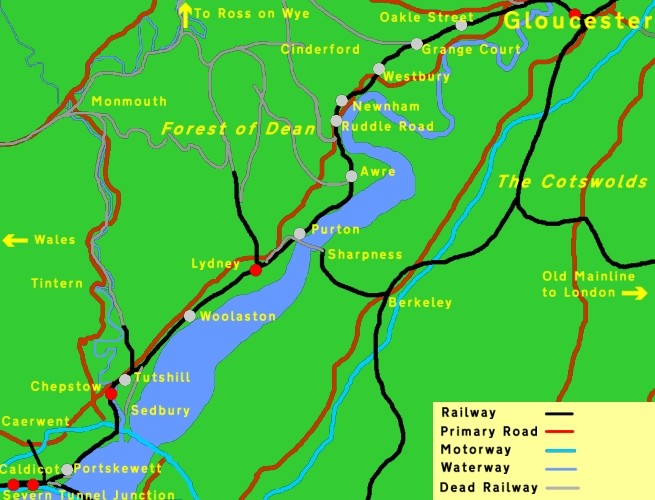 |
Below we have a table showing
pictures of this line and its supply of stations and junctions.
Most of the intermediate stations opened in 1850, and (except
for the Severn and Wye lines) the branches opened over the following
30 years. 1900 to 1955 saw a very slow decline, but then closures
came on thick and fast, and from 1990 until 1995 none of the
junctions for branch lines on the English bank saw any form of
traffic. The route is trying to revive itself now, although the
Severn and Wye (now the Dean Forest Railway) still seems determined
to outlive its younger neighbour, with trains to Lydney Junction
returning in 1995.
|
Severn Tunnel Junction
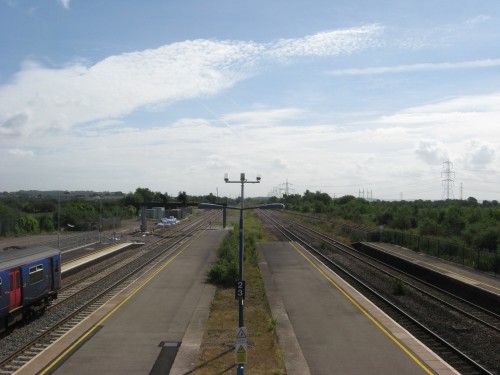
|
Here we see Severn Tunnel
Junction, looking east. For many years it was laid out with three
platforms through which trains ran in two directions. Up trains
(heading towards London) used the central island platform; those
using the Tunnel ran down Platform 3 to the left and those going
towards Gloucester ran down Platform 2 to the right. Down trains
(those heading away from London) all ran through Platform 1 (far
right); when a stopping train was occupying the platform there
was no means of letting anything overtake.
Consequently it was decided
to re-open Platform 4 (far left) so that Up trains for the tunnel
go through Platform 4, Down trains out of the tunnel use Platform
3, Up trains to Gloucester go through Platform 2 and Down trains
from Gloucester go through Platform 1. Work for this was carried
out over Christmas 2009, during which time the few through trains
to London ran via Hereford and Worcester. The station was also
given a bit of an overhaul, with new buildings, display screens,
a visible acknowledgement as to which platform was which (previously
only Platform 2 carried a number) and lots of CCTV cameras. Electrification
is the next upgrade; the previous Government promised it as a
good vote-winner and the new Government has got round to agreeing
to do something about it - not that it's really relevant to this
page, since the old mainline isn't due to benefit.
In the centre is the bay platform
for the Wye Valley line. Any proposal to re-instate the Wye Valley
line would probably not involve re-using this platform, but (despite
it being of no practical use) it has never been obliterated.
Instead it has been filled with rubbish, which is good for the
buddleia. The continued existence of the platform edging epitomises
the run-down nature of the station. The black sign on the lamppost
tells drivers of 2 and 3 car trains where to stop. The train
in Platform 4 is the 10:30 First Great Western service to Taunton. |
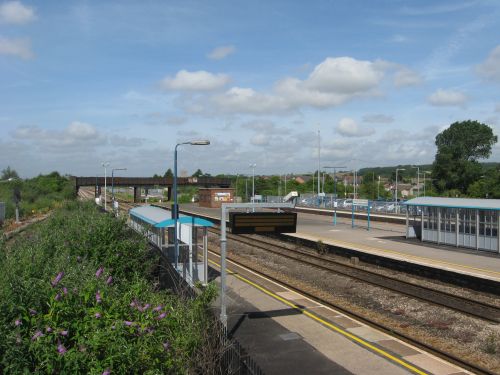
|
Looking the other way, we
see the west end of Platform 1. Hiding behind the pink-flowering
weeds to the left is the freight loop, which can be used by heavy
trains from Gloucester. The old station building for Platform
1 - which would have been awarded "Worst Welsh Station Building
(Large Bus Shelter)" award if such a prize existed and which
really should not be mourned - used to stand where the display
screen is now. Its replacement is the slightly more swish "Voyager"
shelter behind the lamppost (but that's still basic and a longer
walk from the footbridge). The lamp-post was turned around to
avoid damaging it while installing the new shelter and someone
forgot to turn the sign on it back afterwards, which means that
drivers of 2 and 3 car trains no longer know where to stop (although
4 car trains are still told to stop at the next lamp-post). The
island platform possesses the only original building surviving
- an unimpressive empty brick structure whose only function now
appears to be holding up a decorative board. On the far side
is the newly-rebuilt platform 4, along with the station car park.
This photograph was taken from the station footbridge, with the
road bridge in the background, on a fine summer morning in July
2010.
Dotted around the station
are bi-lingual station nameboards, with Welsh on top in green
and English underneath in black - for travellers going through
the Severn Tunnel, these are the last bi-lingual nameboards they'll
see. The Welsh name - "Cyffordd Twnnel Hafren" - is
a direct translation of the English, only it has been turned
around, so a direct translation back would read "Junction
Tunnel Severn". |
|
Caldicot
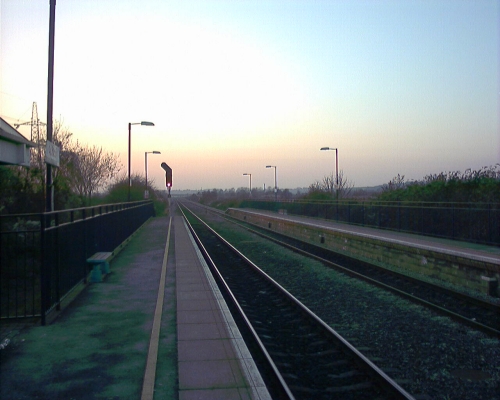
|
Caldicot station is the first
stop out of Severn Tunnel Junction, and a good telephoto lens
can show the platforms of Caldicot station clearly from the footbridge
at the junction. The station has two platforms and presents a
distinctly 1980s air. The buildings are so plain and simple that
there's nothing there to vandalise. Two trains pass through in
each direction for every three hours (with a minimal service
Sundays), so it's not too difficult to get a picture of this
station featuring no trains at all during a winter evening on
Sunday - which is when this picture was taken. |
|
Sudbrook Junction

|
Sudbrook Junction was provided
so that a siding could be laid from the main line to the new
pumping station at Sudbrook. The branch provided access to the
pumps at Sudbrook and allowed coal to be taken in to supply the
furnaces which provided steam to operate the pumps. However,
in 1961 the pumps went over to electric power and the branch
effectively fell out of use.
For some time it appears to
have struggled on, although by the 1990s it was being used exclusively
for stabling the Severn Tunnel Emergency Train. That then moved
to Severn Tunnel Junction, and the connection with the mainline
for the Sudbrook branch was lifted in the early 2000s.
On the other side of the line
was the junction for the line to MoD Caerwent, which headed off
across country to the left and the North, crossed the M4 (now
M48) and entered the military base at Caerwent. Opened in 1939,
it has been run down in recent years and the military presence
has declined to the degree that it has been used for cutting
up old railway vehicles. This traffic has also declined, and
the vehicles were increasingly brought in by road anyway, so
the line now looks somewhat disused, although the junction remains
in place (complete with crossover) and is still maintained. |
|
Sudbrook Branch
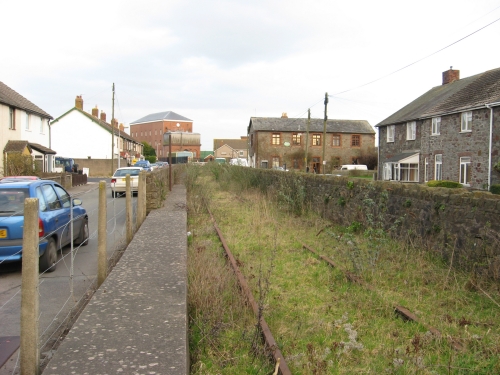
|
The pumps at Sudbrook were
built to drain the Severn Tunnel, then under construction, and
put the water in it into the Severn. It was a late move as initially
it was hoped that such apparatus would not be necessary - until
one day the tunnellers, during their routine digging, uncovered
the Great Spring, which proceeded to pour water into the tunnel
at a rate of 22,000,000 gallons per day. After the Welsh end
of the tunnel had filled with water in about two days (one mile
of mud still separated it from the English end) the pumps were
set up and, after two years, the tunnel was dry again. Happily
it has remained useable ever since.
The pumps therefore continued
to be rail served until their conversion to electric power and
the consequent use of the branch as a siding where the Severn
Tunnel Emergency Train was stored. This was moved to Severn Tunnel
Junction in the early 2000s and subsequently replaced by a pair
of single Diesel Multiple Unit cars built in 1960 and suitably
converted in 2003. All the vehicles associated with the Emergency
trains were placed on the market in late 2007 and sold "as
seen", with practically no mileage on the clock since conversion.
While the last trains to use
the branch have therefore been moved to train purgatory (being
dismantled at Cardiff to provide spares for the Cardiff Bay Shuttle
train, which is of the same design and similar vintage) the branch
itself is in its very own limbo waiting for someone to get around
to doing something with it. As most of it runs alongside the
narrow road through Sudbrook the logical one would be to use
it to widen the road; however, that would allow traffic to get
along it, which is currently out of fashion, and so it will remain
as it is for the forseeable future.
In the background of the picture,
showing the overgrown rails proceeding through Sudbrook, is the
impressive pump house. As the Severn Tunnel runs directly beneath
this line several websites specialising in maps and arial photos
have problems showing the tunnel and this branch, and often end
up suggesting that four IC125s plus several freights and stopping
trains traverse this route every hour, with the tunnel portal
being in the middle of the pumping station. |
|
Caerwent Branch
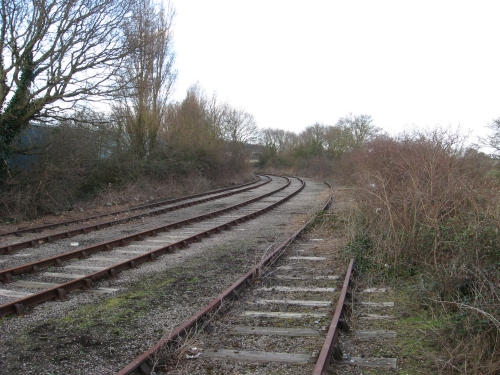
|
While the Sudbrook branch
heads in a fairly straight line away from the mainline, the Caerwent
line turns away sharply to the North, as seen here. Little has
used the branch in recent years, and it is starting to decay
a little.
Opened in 1939, it served
the new military base at Caerwent, which was expected to admit
practically all of its traffic by rail in those days, and so
wanted a good rail link. This line was therefore built across
the 1½ miles to Caerwent, with the first half of the route
mostly in a cutting and the second half principally on an embankment.
Apart from certain track alterations, particularly at the junction,
the only major change throughout its life came when the embankment
was sliced in half in 1966 as part of the construction works
for the M4 when it was extended across the Rivers Severn and
Wye into South Wales.
With the general reduction
in business at the base JT Landscapes expanded their scrap metal
business into cutting up old locomotives and rolling stock at
the rail-linked site. Immediately post-privatisation - from 1998
onwards - was a good time for this, with private operators -
particularly EWS - clearing out vast quantities of old stock.
The demise of the old Mk.1 stock on the Southern Region also
meant big money for scrap metal merchants and over 1000 vehicles
were reduced to scrap metal in two years. JT Landscapes also
got a few of the vehicles displaced from the West Coat Mainline
by the Pendolino programme and duly sliced two coaches and four
Class 87 electric locomotives before the owner found other things
to do with them. The coaches are now deemed to be in short supply
and the 28 spare 87s were sold to Bulgaria. Unfortunately in
2010 the Bulgarian company ran out of spare cash after only taking
delivery of 18 of them, leaving the other ten to face an uncomfortable
future at the hands of a South Yorkshire gas axe. (Only six went
to the gas axe, the other four ending up in Bulgaria anyway.)
No further fleets are slated for disposal now or at any point
in the near future so at the moment the site is empty, but when
vehicles are in residence they are generally visible from the
M48 motorway.
Therefore, while the MoD is
still keeping their track clear, there is no immediate demand
for it at present. |
|
Portskewett
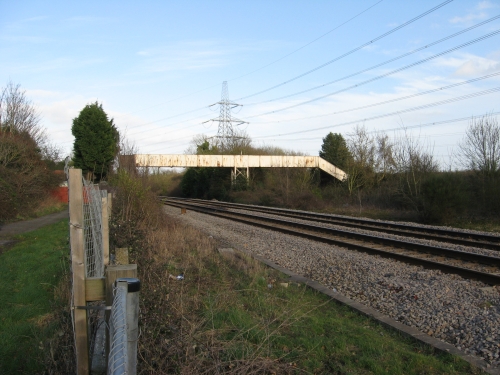
|
The original station at Portskewett
opened in 1850 and lasted just over 13 years before being replaced
by the new one, half a mile closer to Gloucester and a mere 146
miles from London Paddington. This allowed it to become the junction
station for the Portskewett Pier branch - a task which it fulfilled
until the branch closed 23 years later in 1886. It was also briefly
the junction for Sudbrook from 1873 until 1878, when the Portskewett
to Sudbrook tramway was replaced by the Caldicot to Sudbrook
railway. The station slowly decayed to "wayside halt"
status despite being quite well-placed to serve Portskewett and
Sudbrook. The small, attractive station with gardens, buildings
and footbridge with ornate lamps was duly closed in 1964, although
the footbridge survives.
Portskewett itself is a small
place, mostly made up of modern houses, which looks like it wouldn't
mind a new station. Currently there is plenty of room for one,
but it's not on anyone's agenda at the moment. |
|
Portskewett Pier Branch

|
The Portskewett Pier branch
provided access to Portskewett Pier station, which was neatly
built quarter of a mile from Portskewett station on top of Portskewett
Pier. The pier was a large wooden structure which was built to
allow people to board ferries and be carried across the river
to New Passage Pier, which meant a much shorter journey time
to and from Bristol than that via Gloucester.
The branch had a short history.
Opened in 1864, it ran continuously until 1881, when the pier
caught fire. It was re-opened three weeks later and served for
a further five years until closure - it had been superseded by
the Severn Tunnel. The track was duly lifted and the pier demolished
without so much as a farewell special.
Despite the line having been
closed for over 120 years the trackbed is still remarkably intact,
with the picture looking down the last few yards of cutting towards
where the pier used to be. However, Monmouthshire County Council
wishes to use part for the cutting for dumping rubbish in. For
some reason the locals at Portskewett do not appreciate this
idea - soming about how it would involve big heavy lorries. |
|
Chepstow
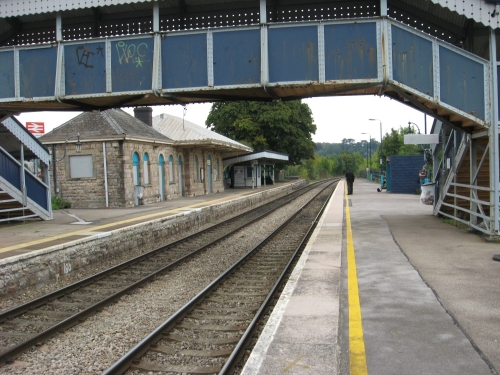
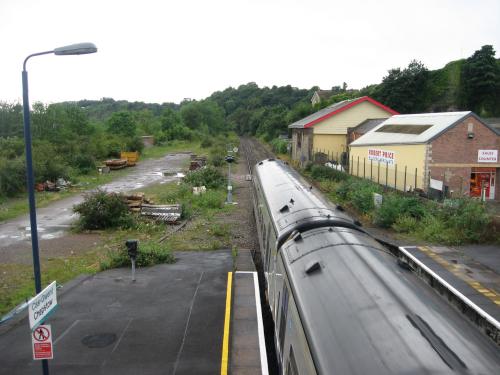
|
Chepstow opened when the South
Wales Railway inaugrated services from Chepstow to Cardiff in
1850. The station was originally Chepstow West, due to there
being another station on the other bank of the river called Chepstow
East. Between the two there was the Wye and a coach service,
this being cheaper (and rather less impossible) than building
a bridge - a policy which continues to this day on the railways
when trying to deal with inconvenient things, like passengers.
On this occasion the problem
was solved by getting Isambard Kingdom Brunel - a notable engineer
of the time - to build a bridge across the Wye. Having built
it, he then tweaked his designs a bit and went off to build a
cheaper (and bigger) version at Saltash, on the border between
Devon and Cornwall, shortly before dying in 1859. The Saltash
bridge survives today, but the Chepstow one was demolished in
1960 and replaced with a stronger one - probably fair punishment
for driving Chepstow East and the connecting rail-replacement
bus out of business.
Chepstow station originally
had low platforms, but these were raised in the 1880s, following
complaints from Wye Valley travellers. The original buildings
- a neat matching pair, one on each platform - were duly jacked
up on heavy timbers and the platforms raised around them. In
1964 British Rail took it into their heads to demolish the Platform 1
building, but that on Platform 2 is original - albeit now with
no proper foundations.
After the First World War
the adjacent shipyards became the Government's National Shipyard
No. 1 - an interesting development which does not seem to have
lasted too long. The massive track network was being reduced
by 1930, and although the shipyards are still open (privately,
and quite limited) the railways have gone.
Today Chepstow is the first/last
station in Wales, looks rather run-down, and has lost its impressive
network of sidings (two headshunts and a bufferstop survive,
none of which can be seen in the lower picture as a Class 158
departs for Cardiff past the goods shed). Despite the miles of
railway which were laid 90 years ago, the current track layout
involves an up and a down line, with a single crossover for stone
trains off the Wye Valley Railway. The surviving building is
a cafe. The blue building to the right in the upper picture has
since been demolished and replaced with a small shelter similar
to those at Severn Tunnel Junction. In the gaps between trains
the station acts as an informal youth centre - passengers do
appear when a train is due, however, and the station can be quite
busy with people heading for the bright lights of Cardiff and
Newport. Currently it is the busiest of the three surviving intermediate
stations. |
|
Tutshill Halt
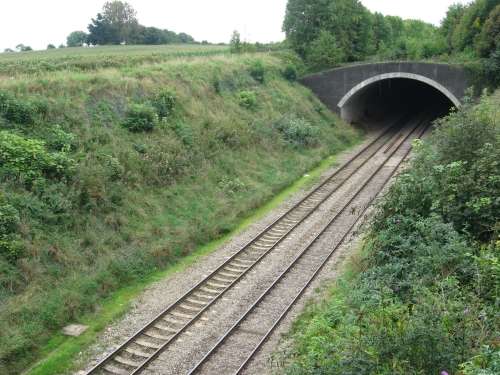
|
Once known as Chepstow East,
Tutshill was eventually re-opened as a halt at the east end of
Chepstow, near the former home of the Harry Potter author - although
not in the exact same spot as its predecessor, which was located
at the end of the cutting, halfway up a cliff overlooking the
Wye. Although the east side of Chepstow sounds like a useful
place for a commuter stop, circumstances conspired against it
- the walk to the main station is roughly 5 minutes, and the
rail journey is about one, so the Ministry of Transport is unlikely
to have seen much point in the extra stop. The Chepstow bypass
- the new A48 which goes across the Wye alongside the railway
rather than winding through the town's main gate and down the
High Street - slashes across the western end of the platforms
and cuts it off from Chepstow and Tutshill. More critically,
the halt had a fairly minimal service amounting only to the Wye
Valley trains, and therefore closed along with the rest of the
Wye Valley route in January 1959.
Little trace now remains of
the halt, and the fact that parking, disabled access, access
for anyone who doesn't like crossing 50 mph roads, and rebuilding
the platforms are all practically impossible ensures that it
is unlikely that trains will ever stop here again. |
|
Wye Valley Junction
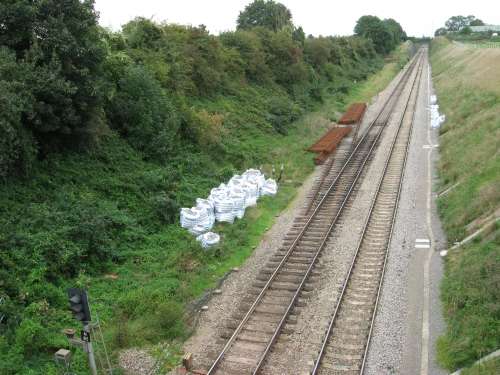
|
On the opposite side of the
road bridge to Tutshill Halt, Wye Valley Junction marked
the point where trains to Monmouth branched off and headed north
into the Wye Valley. The junction was completed in 1876, and
services over the branch started the same year.
The Wye Valley line developed
over the years, but the junction was steadily rationalised. Initially
there were two tracks branching off (one up, one down); this
was reduced to a single track junction with a crossover connecting
the branch to the down main in 1936. A set of catch-points with
a sand-drag were provided instead to catch errant trains.
Following closure of the Wye
Valley line beyond Tintern Quarry in 1964 (passenger traffic
having already ceased in 1959), the junction was simplified again.
The points are now operated by a groundframe, with a ground signal
controlling movements off the branch. The crossover was moved
to Chepstow station, where it remains to this day.
Until 2007 the Wye Valley
Railway had the honour of being one of the last of the six branches
on the English section of the the line to retain its mainline
connection (between 1976 and 1990 it was the only one of the
six to carry traffic). The connection has now been removed at
some considerable expense and to no particular benefit. The branch
had not been used for at least 15 years, although the exact date
of the last train depends on which source you read - a common
problem with freight lines. |
|
Sedbury Junction
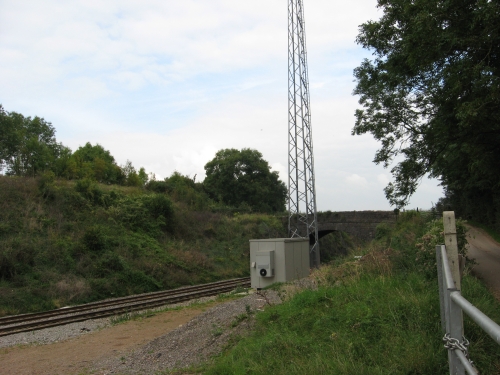
|
You would probably think that
Sedbury village does not look like the sort of place which could
justify a rail service with Chepstow and Tidenham stations so
nearby - and you would be right, as it couldn't. Instead, the
branch was opened to serve the shipyards at Beachley - a village
sandwiched between the Severn and the Wye. These shipyards -
the National Shipyard No. 2 - were built from 1917 to 1919, with
the railway being built to serve them. The yards were then closed
again in 1919 (imagine what the tabloid response would be today)
and the railway was then progressively shut down. Workmans' trains
were inaugrated in 1919 but withdrawn in 1920, with the junction
being removed in 1928. A loop line - there were originally two,
but the outer one was lifted in 1931 - survived until 1968, along
with a signal box.
The junction was complicated
by the existance of a lane to Sedbury which crosses the railway
on a bridge at this point - while the Wye Valley line (above
the mainline to the left) simply goes over it, this line wants
to be at the same level as the road, and spent about a third
of its life (1 year) passing under the road, leaving the mainline,
and heading south - this was revised for the remaining two years
of its life with the junction and signal box being on the east
side of the road, and the railway then climbed away and crossed
the road on a level crossing.
The site of the original junction
is still railway land, and is now used by a radio transmitter
for signalling between trains and the signal box at Newport.
The military retain a presence at Beachley to this day in the
form of an MoD base which seems to have opened at the same time,
but didn't justify a rail link on its own. |
|
Woolaston
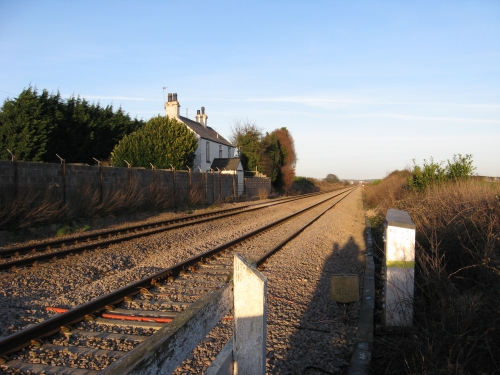
|
Not lost to quite the same
degree is Woolaston station. It is clear that there was a station
here - it is shown on the 1960 map of the area as a closed station,
and the station building still survives, visible in its smart
coat of white paint. The station, which lasted for precisely
101 years 6 months (1st June 1853 to 1st December 1954) was never
a very major stop, with four trains each way each day halting
alongside the level crossing - which gave access to three fields
and the down platform. The village itself was half a mile away,
at the other end of Station Road, with the inhabitants mostly
living on the other side of the A48.
Woolaston can hardly have
been helped by the fact that, with a good telescope, you can
almost see the platforms of Lydney station, two miles away as
the crow flies (and as the train runs, since the marshes which
the railway is built on are dead flat and the railway is therefore
completely straight). In life it was a quiet wayside station;
in death it provides a constant barrage of noise as a kennels
and cattery, which ensures that Station Road bustles with the
kind of continuous traffic which it is unlikely to have ever
been subjected to during its lifetime. If you are heading from
Wales to Lydney with a bike, Woolaston station marks the point
where you should think about getting up to find it and wheel
it to a door. |
|
Lydney
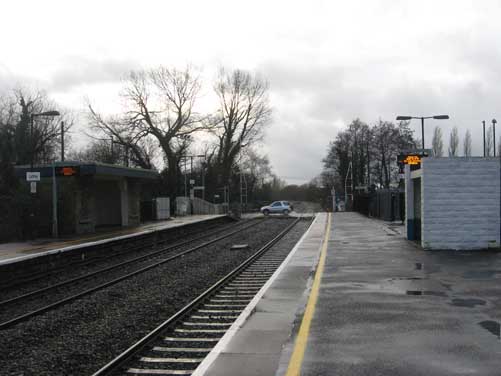
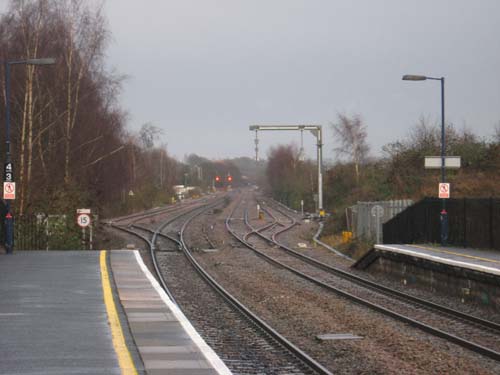
|
Adjacent to the southern terminus
of the Dean Forest Railway, Lydney station is a fully-traditional
railway station - it is a mile from the town it purports to serve,
and is outside the area encircled by the by-pass. In a bid to
make up for this, various people have put lots of luxury housing
along the road to Lydney Docks, about half a mile away to the
south-east, and so Lydney station is actually near some houses.
The station's main building was on the
up side (right in upper picture), with a shelter on the down side (left in upper picture). The Up
building was eventually demolished and a small concrete shelter - now
garishly carrying Arriva Trains Wales colours - replaced it. The Down building
would appear to be original, albeit with the windows sealed up.
Originally the level crossing
in the distance was a rail over rail crossing, with the Severn
and Wye Railway line to the docks passing across the main line
on its way down from the Forest of Dean, which is to the right,
on its way to the Severn Estuary, which is to the left. After
the docks line closed the railway was converted into a road -
not terribly busy, but enough traffic comes this way to provide
a picturesque queue for the crossing gates.
The Severn and Wye Railway
arrived here before the mainline, as a tramway which eventually
found the money to upgrade to the broad gauge used on the mainline.
The mainline was then converted to standard gauge and, after
much grumbling, the Severn and Wye followed suit. By 1920 it
had a massive network in the Forest, with a main line to Cinderford,
a loop line which turned much of the northern half of the line
into a giant lasso around the centre of the Forest, and branches
to Lydbrook and Coleford. Passenger services beyond Lydney Town
ceased in 1929 and the network was steadily cut back over the
next 30 years until only stone trains to Whitecliff Quarry, near
Coleford, survived. These were then reduced until closure of
the network in 1976, which freed up the surviving Lydney to Parkend
section for preservation by the Dean Forest Railway Society.
The Severn and Wye is still
linked to the mainline - via a connection into the loops at the Gloucester
end of the station seen in the lower picture - and the link is used by the occasional
railtour. It is the last such link to survive on this section
of the route since the removal of the connection at Wye Valley
Junction. The station no longer has its own signal box however.
In its latter years the neat timber structure was a gate box
controlling this crossing and that at Awre, but in 2012 these
duties were transferred to a new signalling centre in Cardiff
and the box was demolished that December. |
|
Severn Railway Bridge
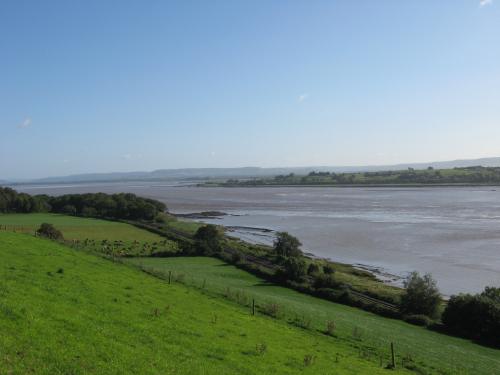
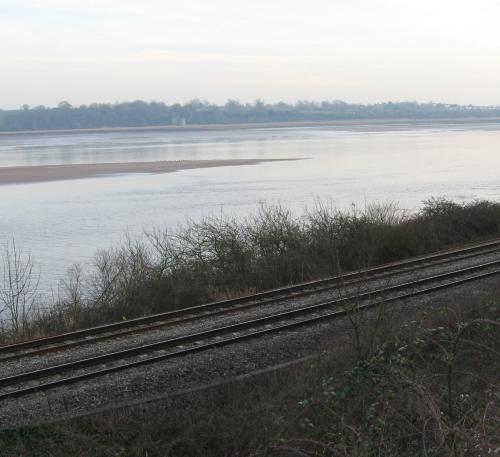
|
In many ways one of the greatest
engineering achievements of the Victorian era, the Severn Railway
Bridge spanned the River Severn at Sharpness from 1874 until
1960. It was a single track construction, built to carry Forest
of Dean coal to Sharpness Docks for export, and provide access
to the Midland Railway on the East bank of the river.
The Severn and Wye Railway
was struggling at this time, and quick construction of the bridge
might have staved off bankruptcy for a few more years. As it
was, the company rapidly found itself saddled with the even more
impoverished Severn Bridge Railway, which came with the sort
of astronomical maintenance costs which can be expected from
half-mile long bridges. The result was that the Severn and Wye
Railway began looking for buyers; after some blackmail, the Midland
Railway took over the southern end and the Severn Bridge, and
the Great Western Railway took over the section to the north
of Parkend. This mixed ownership lead to the railway network
retaining an individual flavour until it became part of the new
British Railways (Western Region) in January 1948.
The bridge remained upright
until a thick fog on the 24th October 1960. Two boats coming
up the river were tied together by crew members standing on the
bows (the front), in fog which was so thick that the captains
couldn't see that this had happened. The rising Severn tide swept
the vessels up the river past Sharpness Docks and straight into
pier 17, which disappeared in a large bang and a fireball - along
with the bows of the boats, five of the nine crewmembers, two
spans of the bridge, and the gasmain to Lydney.
Passenger services across
the river into Lydney Town station were promptly suspended, leaving
Lydney station on the mainline as the railhead. The inferno which
resulted from the accident as the fuel for the boats poured into
the river covered the whole distance from Lydney to Sharpness
and made escape very difficult. Fortunately the sport was on
the radio, so the track maintenance team were hiding in the Severn
Bridge signal box rather than patrolling the bridge.
Although at the time work
was being done to strengthen the bridge, it was never rebuilt
and a second strike on pier 21 two years later saw the decision
taken to demolish the crossing. Two contractors were bankrupted
by the job and it was ultimately never completed, with the support
for the swing bridge over the canal and approach viaduct at the
Sharpness end remaining intact to this day.
The occasional noise is made
about re-instating it, although it reality it remains a virtually
impossible pipe dream. More likely is the return of rail services
to each end - the railway is still intact into Sharpness and
re-opening could be achieved very cheaply. The other side, where
Severn Bridge station stands at the end of the embankment, is
of vague interest to the Dean Forest Railway, although the line
ran a little close to the modern Lydney bypass.
The upper photograph looks
up the west bank. The mainline curves into a bank of trees to
the left where the bridge once left its embankment to stride
across the river, roughly where a mudflat now runs into the tidal
estuary. The lower picture, from a road in the village of Purton,
looks across the Severn towards the faint grey smudge marking
the eastern approach viaduct and swing bridge support. |
|
Gatcombe
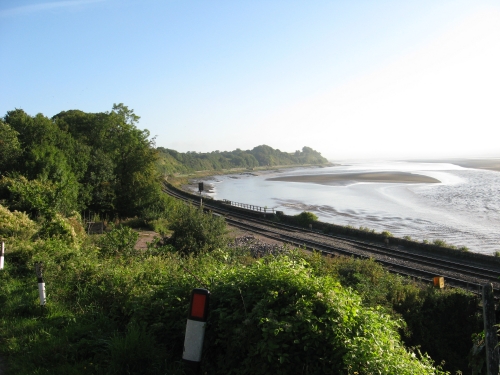
|
Gatcombe station was a typical
railway station in that it was in Purton. To reflect the fact
that Gatcombe itself is a half a mile away, it also carried the
name Purton Passage, and was located just above the slipway from
which the ferry would cross the river to Purton. The fact that
two places on opposite banks of the river are called Purton suggests
that it was quite easy to get across the river once - the ferry
is now long gone however, and the fact that Purton (Gloucestershire)
is about twenty road miles from Purton (Gloucestershire) is merely
a cause for confusion.
Gatcombe station (which was
precisely 130½ miles from London Paddington via Gloucester
- the milepost was halfway down the platform) opened with the
line in 1850 along with Gatcombe Goods, which was back up the
line at milepost 130 in Gatcombe itself. It was a simple two-platform
affair, probably with small wooden buildings and low platforms,
which does not appear to have been terribly successful. Unlike
many stations and branch lines in the country, its closure cannot
be blamed on Dr. Beeching, whose recommendations were published
94 years after this station was closed and demolished in favour
of Awre in 1869. Curiously the walk from Gatcombe to Awre Junction
is less strenuous than the one from Gatcombe station to the village
which it purported to serve. Gatcombe Goods (one siding and a
crossover) had a similar lifespan, with its traffic being handled
by Blakeney instead. This probably means that Gatcombe Goods
was built to handle Blakeney's freight traffic.
Purton was also due to play
host to a tramway which would have climbed up the hill from Purton
Pill and then run in a level sort of manner up the valley and
across farmland to somewhere. Only a short three-arch viaduct
which crosses the road into Purton was built, with the result
that there is a very effective 200 year-old block on vehicles
more than 15 feet tall approaching the village from the east. |
|
Awre Junction
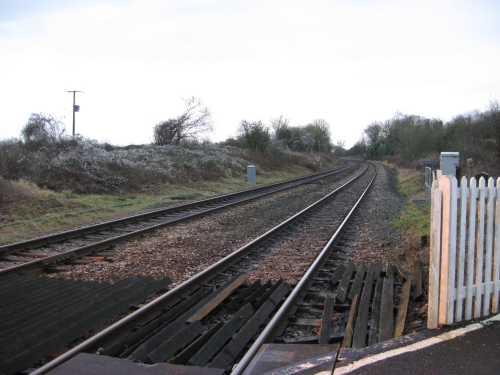 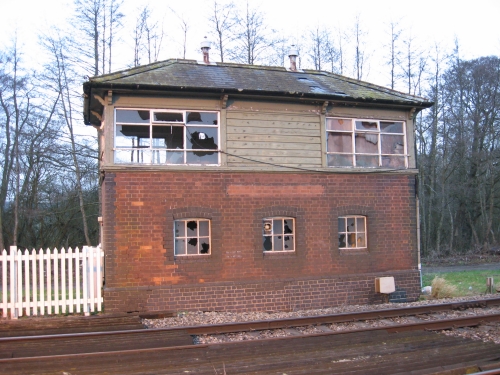
|
Awre [pronounced Orr]
was not the most important junction on the route; if anything,
it was one of the bottom two. In the mid-19th Century, rail services
to the centre of the Forest of Dean were somewhat lacking, and
so a new railway - the Forest of Dean Central Railway - was promoted
to run from the mainline at Awre Junction, through Blakeney and
on to the collieries north of Mallard's Pike - a lake in the
depths of the Forest. There was also a bridge over the mainline
for a branch down to the Brims Pill on the banks of the Severn
- although they forgot to open that bit, the embankment is still
visible. Awre station was opened with the new branch line in
1869 and provided a slightly better passenger service to Blakeney
and Awre. Blakeney also got a convenient, if rather rubbish,
goods service from the branch line, which never saw a passenger
train.
The response of the Severn
and Wye Railway was to build the Severn and Wye Mineral Loop.
Leaving the Severn and Wye at Tufts Junction, on todays Dean
Forest Railway south of Whitecroft, it headed northwards past
Mallards Pike to rejoin the Severn and Wye at Drybrook Road station,
near Cinderford. Trains which ran up the entire loop would ultimately
end up facing back towards Lydney, due to the design of the junctions.
The Forest of Dean Central
tried to compete, but failed. The whole line was open for 10
years, but in 1878 it was officially reduced to only serving
some sidings in a particularly quiet part of the Forest. The
Severn and Wye did give it a bridge to allow it to access the
area beyond New Fancy colliery, but otherwise had actually eliminated
the threat from its smaller competitor as soon as it opened its
own line.
By the Grouping in 1923 much
of the route was disused, and from then until 1949 Blakeney was
the terminus, after which the line remained technically open
for a further ten years, prior to full closure in 1959. The junction
station was closed to passengers at the same time.
Although the route is still
clearly visible throughout, Awre Junction has long since been
flattened, with just the level crossing, the ruins of the Station
Master's house and the signal box surviving. How long the signal
box will remain for - or how long the house will remain visible
through the ivy - is debatable.
The box was retained to control
the adjacent level crossing, which is a full barrier affair with
flashing lights, sirens, and fast trains. Modern CCTV technology
means that the crossing can be controlled from elsewhere, so
the honour moved to Lydney in 1974 with the aid of some bright
floodlights for after the Sun's bedtime. Consequently the box
has been closed, and the nameboard removed, but it remains intact,
albeit slightly vandalised - its survival probably being helped
by the 24-hour security which is a must here, and therefore will
help prevent vandalism. Control of the crossing passed on to
Cardiff in 2012 and Lydney was promptly relieved of its box.
There is a longer article
on the Forest of Dean Central Railway here. |
|
Bullo Junction

|
Bullo is a curious name. Home
to Bullo Pill, it was also the junction for the Forest of Dean
Railway. It ran north from here towards Cinderford, serving the
many collieries and ironworks along the way, and eventually deigned
to offer a passenger service.
It is debatable as to whether
this line or the Severn and Wye was the more successful. This
route, which was ultimately entirely owned by the Great Western,
had the smaller route mileage and also never opened its northern
extension - a long branch line from Cinderford to Mitcheldean
Road on the Hereford, Ross and Gloucester Railway, with two tunnels
and steep gradients. It was completed in 1874 - the year after
the Severn and Wye began work on their own Lydbrook branch, which
gave access to the Ross and Monmouth Railway - albeit in a way
which forced northbound trains to run-around at the junction.
Rather than compete, the Great Western forgot about their line,
and left the route to rot. Part of the line was subsequently
used for passengers services, and a further half mile was used
to serve a quarry. The northernmost tunnel was never used by
Great Western trains, although the Admiralty subsequently used
it for missile storage. Following the Second World War, the line
was cut back, with passenger services ceasing in the 1950s alongside
the demise of most of the collieries along the route. Traffic
finally ceased on the 1st August 1967. The junction cannot be
viewed from public roads or footpaths and the best way to appreciate
it is to pass through the overgrown site - once home to an engine
shed, water tower and several sidings - on the train.
The route has a large supply
of trivia in its history, with the southernmost (Haie Hill) tunnel
causing several problems due to it being two-thirds of a mile
long on a steep uphill gradient with no ventilation shafts. Ridiculously
long trains of 100 wagons or more were hauled through by small
tank engines until one fireman ended up being carried out of
the smoke-filled hole on a stretcher. After this crews refused
to work the line with more than 40 wagons, much to the annoyance
of the railway company. During the early 1960s, Dr. Beeching
recommended closure of a number of railways around the country;
when a lorry crashed into the bridge over the A48 near Bullo
it was suggested locally that Beeching had been driving the lorry
at the time. The bridge was rebuilt and survived for three more
years before closure. There are no plans to re-instate this route. |
|
Ruddle Road Crossing Halt
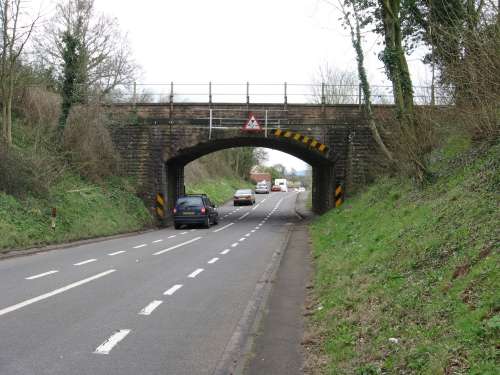
|
Ruddle Road Halt was a short-lived
affair. It opened when a passenger service from Newnham to Cinderford
was launched in 1907. It is unclear what traffic it was expecting
which would not be better served by Newnham station, which had
mod-cons like local population, a waiting room (rather than a
hut) and through trains to Gloucester. The lack of traffic was
noticed during the First World War, before anyone had photographed
the halt, and it shut in the 1917 round of closures. It was demolished
in 1920, but did get to feature on an Ordnance Survey map from
about that time.
The design was very simple
- two wooden platforms, staggered so that there was one platform
on each side of the bridge (whichever direction you approach
said bridge from, the footpath up to the platform is on your
left). The bridge is one of several where what was once the South
Wales Railway crosses what is now the A48 on a stone arch which
is too low for modern requirements. Consequently large vehicles
are encouraged to go down the centre lane under the highest point
of the arch; larger vehicles are encouraged not to go beyond
Blakeney, as between there and Gloucester there are a series
of these bridges, all at about 14ft high.
Despite being abandoned for
90 years, the approach paths are still quite healthy - particularly
the westbound one, which can be followed up to the railway. This
picture was taken from the north side of the bridge. |
|
Newnham
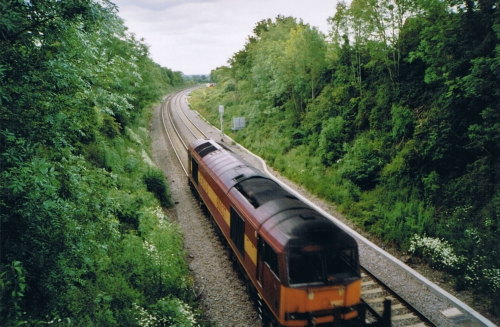
|
Newnham opened with
the main line to serve the village of Newnham, but it rapidly
became the junction station for the Forest of Dean branch. It
was soon realised, however, that if the branch was to be opened
up to passenger trains there would be certain operational problems
at the two platform station as the branch train would terminate
on a through platform and hold up the traffic while the locomotive
ran around.
Eventually the station was
rebuilt with a bay platform on the south side, allowing branch
trains to terminate clear of the mainline. "Railmotors"
were introduced at the same time, running to Drybrook in the
north of the Forest. Railmotors were wooden bodied coaches with
a cab at each end and a boiler fitted just behind one cab, allowing
them to travel around, literally, under their own steam. This
eradicated the need for the loco to run around, so there was
no need for a loop. The railway had recently been converted from
broad gauge to standard gauge, which meant that there was plenty
of room for the extra platform when it was added in 1907.
Newnham is a small town with
a large clock tower by the A48 to give it a busy feel and the
station was not far from the centre, so the rail service will
have seemed fairly secure. The branch railmotors were replaced
by the Great Western's "push-pull" system (see Oliver
and Isabel in the Thomas the Tank Engine books - a tank
engine pulled a single coach up the valley and pushed it back
down) in the 1930s, and the branch closed to passengers in 1958,
although the bay had been falling into disuse long before then,
as trains began to run straight through to Gloucester - a sign
that British Railways was beginning to appreciate the need to
carry passengers with as few changes of train as possible. It
was not enough, however, to save either the branch or the station.
Trains have not stopped at
Newnham since November 1964, except when held at signals. Sufficient
room remains, however, to re-instate the station - maybe one
day. |
|
Westbury-on-Severn Halt
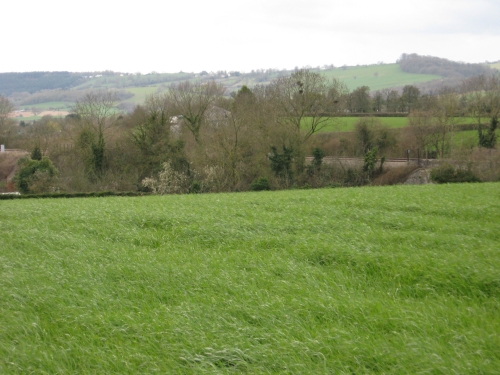
|
Next was Westbury-on-Severn
- a small halt which lasted for 31 years, one month and one day
before closure on the 10th of August 1959. Being an insignificant
little halt (rather than an insignificant little station) it
had no goods facilities. Instead, it had two basic wooden platforms
with a small galvinised metal shelter halfway along each, along
with a couple of station nameboards and some lights. It was located
between two bridges- the first carried the railway over the A48,
and the second carried the railway over the Blaisdon road.
Westbury-on-Severn is part
of a larger conurbation of various houses and areas of woodland.
The halt was only 1½ miles from the larger station at
Grange Court, which was also easily accessible from the village
- this may well have sealed its fate.
The photograph was taken from
an adjacent hillock. Behind the trees in the centre was the halt.
The far bridge, also hidden behind the trees to the left, crosses
the A48. |
|
Grange Court
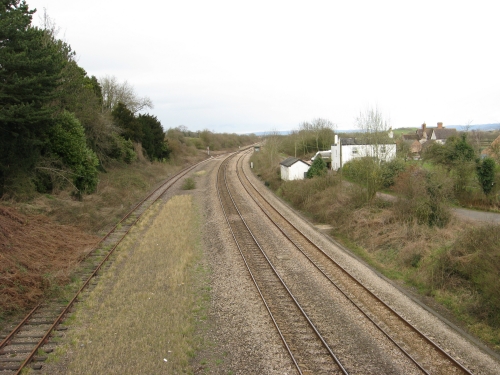
|
Grange Court was junction
for Mitcheldean, Lea, Ross-on-Wye and Hereford - a spendid four
platform affair (two on the left and two on the right, the centre
pair being an island platform). Both routes were intended as
through lines to South Wales - that to the right being the mainline
to Swansea via Chepstow and Cardiff, while that to the left was
the mainline to Swansea via Hereford and Brecon.
The Hereford route was helpfully
built as single track, somewhat limiting its ability to attract
the traffic required to justify its many bridges and tunnels,
so the line closed during the Beeching era in 1964. Grange Court
was principally a junction station, and therefore there were
no nearby towns or sizeable villages, resulting in it following
its branch line into the history books in the same year. Its
pride as an intercity junction was somewhat spoilt by the payroll,
which in typical minor rural junction style featured a cat -
not that the cat got much choice on what it spent the pay on
(catfood from the corner shop mostly).
The loop lines remained intact,
but in 2004 Network Rail expressed an interest in removing excess
sets of points along the Severn Tunnel Junction to Gloucester
line. After funny noises were made at Lydney, it was pointed
out by the Dean Forest Railway (who wanted to keep their loops
and the associated mainline connection, thank you very much)
that there were two loops at Grange Court lying around doing
nothing. Eventually in 2010 they were disconnected from the mainline
and the crossovers removed, but the signal at the East end of
the Up loop is still on, glowing red at any trains which manage
to end up in front of it.
A curious little feature of
how this route was built means that Grange Court was a junction
between three railway companies - the Hereford, Ross and Gloucester
from Hereford, the South Wales from Chepstow and the Gloucester
and Dean Forest from here to Gloucester. It is doubtful as to
whether the passengers ever noticed this, since all three railways
were worked by the Great Western from the outset. |
|
Oakle Street

|
The last station before Gloucester
was that at Oakle Street. The small station was surrounded by
small villages, and the station took its name from the nearest
- the village of Oakle Street, which appears to be named after
the road. The nearest two villages of any size are Churcham and
Minsterworth (curiously both named after Christian buildings
of worship) which provided enough business to encourage the station
to open with the railway in 1851, but not enough to save it from
early closure four and a half years later in March 1856.
This was not the end for Oakle
Street, however, and it re-opened in October 1870 to passenger
and goods traffic. Things seemed to have remained healthy until
1953, when the signal box closed, with the replacement groundframe
being locked in and out of use by Grange Court signal box. Goods
traffic ceased altogether in August 1963, although passenger
services struggled on for a further 14 months before the station
closed forever in 1964.
The site has now been cleared.
It is hard to believe that there ever was a stop here as trains
clatter up the straight from Grange Court at 75mph on their way
to Gloucester. |
|
Over Junction
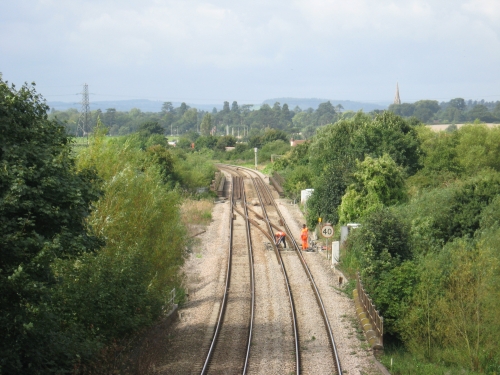
|
The last junction before Gloucester
was that for Newent, Dymock, and Ledbury. It was the archetypal
minor cross-country branch line, running for about twenty miles
through the middle of nowhere, and receiving the usual minimal
service.
Although an attractive line
(all minor closed branch lines are attractive according to their
sweet rose-tinted obituaries), the railway was not frequented
by enthusiast specials, or indeed by passengers, who were all
notable, even on the last day, by their absence. The railway
therefore closed as part of the 1959 round of cuts, and nobody
outside its immediate area appears to have been particularly
distressed that the 1885-opened railway was no longer providing
its apparently unnecessary service to the community.
The junction was as far east
as possible while staying on the west bank of the Severn. It
was a fairly simple affair with two tracks crossing the river
and heading off towards Severn Tunnel Junction while two other
tracks turned north, rapidly dropped to one, and wound off into
the countryside. Nowadays a signal sits in the middle of the
branch line, in the distance beyond the bridge. On the other
bank of the Severn, where the lines to the docks once branched
off, a trailing crossover now connects the two tracks of the
mainline with men in orange jackets looking at it thoughtfully. |
|
Gloucester Central
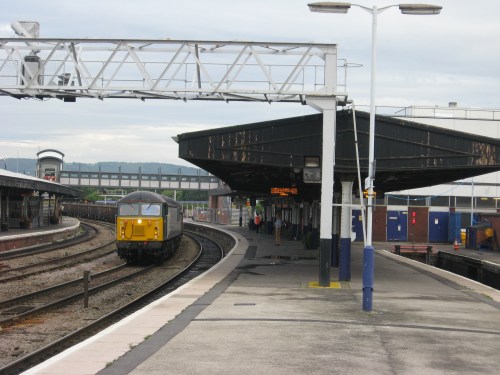
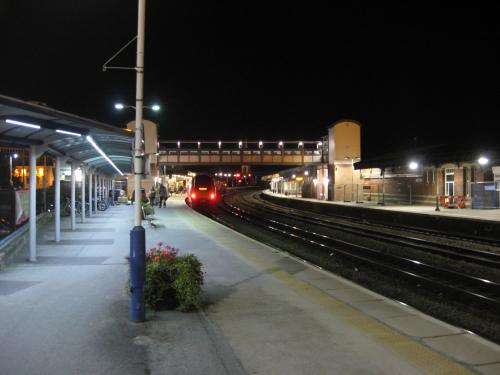
|
Gloucester Central station
was home to one of the more notable points where railway passengers
of the 19th century were inconvenienced due to some railway politics
and excessive displays of engineering genius. When George Stephenson
began building successful railway locomotives he built them to
work on his local railways, where the rails were 4ft 8½
inches apart. This rapidly became standard for all railways which
were built by British engineers or engineers influenced by Britain
- in other words, most of the world. Mr Odd-One-Out was better
known as Isambard Kingdom Brunel, who thought that the traditional
track gauge (distance between the rails) was inadequate - and
so when the Great Western Railway opened in 1836 it was to a
new 7'¼" broad gauge. (It was not entirely illogical.
When the Great Eastern Railway was formed its first task was
to resolve problems caused by Norfolk, Suffolk and Essex each
having their own track gauge of around 5'.)
This was fine until railways
began to meet up and the most notorious example of this was at
Gloucester. This was the lowest easy crossing point on the River
Severn, so when the Birmingham and Gloucester and the Bristol
and Gloucester arrived virtually simultaneously they naturally
built a joint station pointing at South Wales. This required
a reversal for through Birmingham to Bristol traffic, which was
fine since it made changing locomotives easier - at least, it
would once the two railways had agreed which one would have to
convert to match the other's track gauge. The result was an interesting
picture entitled "The Break of Gauge At Gloucester",
with all the mail, the passengers, their children, their animals,
their luggage, their porters, their kitchen sinks, etc., trying
to get from one train to the other - and the standard gauge stock
was also noticably smaller.
The east-west extensions to
South Wales and Swindon were built to the broad gauge, but the
two north-south concerns were purchased by the Midland Railway
who converted the Bristol and Gloucester to standard gauge. Once
east-west operations had passed to the Great Western the break
of gauge was made less obvious by the Midland upping sticks to
its own through station at Eastgate, forcing passengers to engage
in such a lengthy walk to change trains that they didn't notice
the track gauge.
Broad gauge was scrapped locally
in 1872, resolving track problems for goods trains and leaving one easily noticable oddity on
the Gloucester - Severn Tunnel Junction route, among others,
in that the tracks are further apart than usual - about 10 feet,
rather than 6. The problem of two stations remained until 1972,
when British Rail and Gloucestershire Council came up with a
solution. BR could close Eastgate station, and Gloucestershire
Council could say that they'd asked them to do it due to the
excessive traffic in Gloucester being held up on the five level
crossings on the two-mile loop.
Although Eastgate was the
superior station from the operations point of view, it shut in
1972 and was replaced by a new road. The traffic is as bad as
ever, but the long-distance Bristol to Birmingham trains use
the avoiding line and do not stop at Gloucester, as this would
require them to turn around and go back out of the station the
way they came in. Instead, they stop at Cheltenham. Gloucester
- with its one train per hour to London, one per hour to Weston
Super-Mare, two per hour to Newport, and four per hour to Cheltenham
- tries to pretend that it doesn't care.
The yard at the east end of
the station became home to Cotswold Rail - a loco-hire company
and tour operator - until they went bankrupt in 2009. Antique
diesel traction in the area is now provided by Colas Rail and
Devon and Cornwall Railways - the latter offering the Class 56
seen in the upper picture squatting on a through road preparing
to head for South Wales. Few passenger trains now start here
so the west end bay (platform 3) to the right is largely used
for stabling stock. The lower picture looks from the other end
of Platform 2 late at night, with Platform 4 off to the left. |
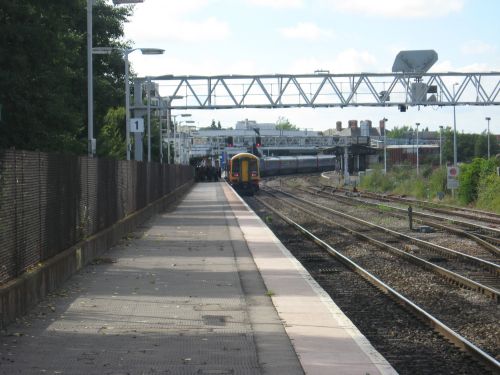
|
Following the closure of Eastgate
station BR came up with another great idea - they closed what
is now known as Platform 4, which allowed them to remove the
footbridge. Of course, this left them with inadequate platform
space, so they put Gloucester Central into the record books by
building Platform One.
This picture was taken from
one end of this great platform. What you can see in this picture,
stretching into the far distance, is not all Platform 1. Just
after the red lights and at the other end of the teminating train
it turns into Platform 2, which has all the main buildings on
it. Most trains to and from Cheltenham use Platform 1 - it probably
saves about 5 minutes of journey time. In exchange, First Class
passengers on expresses turning back here are subjected to a
ten minute walk to the main buildings. First Class passengers
for the stopping service towards Newport used to have to walk
down to Platform 3, which is at the other end of Platform 2.
In total, Platforms 1 and 2 are 602.6 metres long - about a third
of a mile, which is nearly long enough for three full High Speed
Train sets and means that they comfortably hold the record for
the longest continuous platform face in the country. On the lamppost
at the very end of Platform 1 is a sign pointing to the "Way
Out" - the only exit is in the main station building - quarter
of a mile away!
Very kindly, the HST services
from London to Cheltenham have taken to turning back in Platform
2, thereby making the walk rather shorter. One of them can been
seen in the far distance. |
|
The current passenger
service is provided by four fleets of trains, although only two
put in regular appearances. The Arriva Trains Wales fleet principally
consists of trains built in the the 1980s and early 1990s, while
the (also Arriva-operated) Cross Country fleet is made up of
1990s stock. |
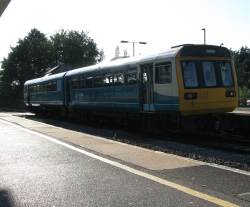
|
When in the 1980s it was decided
to replace the 1950s Diesel Multiple Unit fleet BR decided to
be clever and came up with two options - a cheap Leyland bus
pretending to be a train and a modernised, highly-expensive version
of the Southern Region's long-distance semi-fast diesel units.
The former failed to win any prizes for reliability and the latter
failed to win any orders, so after the two ideas had been mixed
with some ideas from their predecessors the Sprinter fleet was
born.
Unfortunately someone decided
that the bus pretending to be a train was too good an idea to
drop, although it took five prototypes, a trial fleet and four
years to produce a working design (unlike the Sprinters, which
took four trial units and six months). The result was the Pacers,
or Classes 142, 143 and 144; although the last of these tends
to stick to the North-East of England, 142s and 143s are a mainstay
of Valley Lines services radiating from Cardiff. Occasionally
one escapes onto a longer-distance working and this 142 is seen
at Lydney. Usually they handle the Sunday services. To be fair
to them, the decent track out here means that they ride well
and the wide bodyshells and big windows give them a spacious
air. |
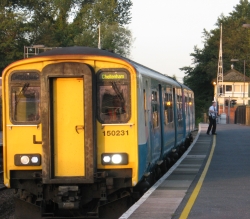
|
The Sprinter fleet developed
somewhat over the years - the prototypes were two three-car sets
with no corridor connections on the unit ends, while the initial
production batch were two-car sets similarly devoid of doors
at the ends of the units (although they were now too short to
work single-handed on most routes, requiring twice as many units
to work the services and for them to be provided with two guards.
An excellent economy by the Treasury there. Both problems were
largely solved by hoping that the overcrowding would get rid
of the excess third of passengers).
The Class 150/2 units were
obligingly fitted with large doors bunged into the fronts of
the cabs to allow passengers and crews to move between sets.
Cardiff held out for a large allocation when the fleet was built
but progressively lost almost all of them over the years. Recently
various bundles have been drifting back and Arriva enthusiastically
painted them all in turquoise and cream in the hope that this
would ensure that they stayed here. Five duly ended up on short-term
hire to First Great Western. This one didn't; instead it is seen
on the first train of the day one fine September day at Lydney. |
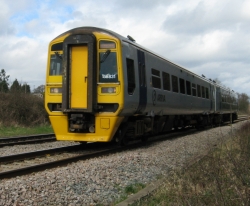
|
The Class 158 "Express
Sprinter" fleet began arriving in 1989, with the first units
being allocated to Scotland. They were 90mph units and fitted
with air conditioning - although someone knew that it wouldn't
work and gave them emergency "hopper" windows too.
Initially South Wales's longer-distance Sprinters came in the
form of all 35 Class 155 "Super Sprinter" units, but
these had some reliability problems and eventually ended up being
rather cut up over it.
With the two-car 155s reduced
to single-car 153s and despatched to rural branchlines all over
the country, the 158s found their way to South Wales and the
Severn Tunnel Junction to Gloucester line. They also suffered
minor reliability problems and the gases in their air-conditioning
systems were subsequently banned for being bad for the environment,
but they have settled down to being a good fleet. Privatisation
saw the entire Wales and West fleet get a nice refurbishment
which was so good that hardly any of them have been touched since.
Arriva's 158 fleet is now based at Machynlleth and used on Cambrian
Line duties, so they are a bit rare down here these days but
pop by occasionally. This one is seen from a public foot crossing
at Bullo, heading down towards Cardiff (the only one of these
five pictures showing a train going in that direction). |
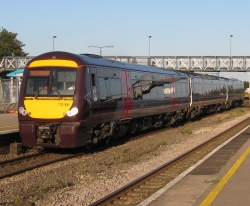
|
Some evolution of the Express
Sprinter design followed in the run-up to privatisation, resulting
in a fleet known as the "Turbos" being built for London
commuter services. After privatisation the new owners of the
former BR engineering division developed the design some more,
resulting in the Turbostar.
Two-car sets were soon to
be seen on Midland Mainline stopping trains; although a bit rattly,
they looked good and had nice big windows, so passengers flocked
to use them and they were increased to three cars. Then Midland
Mainline went back to the builder and bought some bigger trains,
the design having evolved into the Voyager in the meantime, and
the Turbostars passed to Central Trains. After re-franchising
they ended up with Cross Country, which has repainted them all
into a maroon and silver livery which rather suits them (accompanied
with an interior refurbishment which cleared out the worst of
the rattles). They work between Cardiff and Birmingham and don't
bother to stop between Newport and Gloucester, so when seen at
Severn Tunnel Junction the sixth member of the fleet was doing
about 75mph as it roared along in a happy Turbostar manner. |
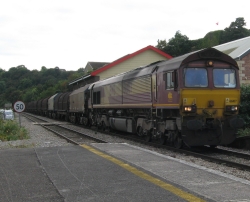
|
Freight traffic continues
to make up a sizeable portion of the stuff trundling between
Severn Tunnel Junction and Gloucester, although there isn't as
much as there used to be and it is now all through traffic, with
no sources of income en route. The bulk of business now
consists of steel from Port Talbot (east of Swansea) and Tremorfa
(in the Cardiff Docks area) with some oil from Milford Haven
(the far west of Wales).
These freight trains are mostly
hauled by locomotives operated by the former English, Welsh and
Scottish Railway (or EWS, an American-owned firm) but this company
has been bought out and is now called DB Schenker (owned by Deustche
Bahn, the German State Railway). EWS traditionally worked everything
along here with Class 60s, but decided that all of them seemed
to look rather grumpy about something and the last couple of
years have seen almost all workings pass to newer, North American-built
Class 66s. The 107th example of this vaguely optimistic-looking
design is seen yinging through Chepstow on its way up the line
with a steel train. |
Notably the line bypasses
or skirts round most intermediate population centres. Prior to
construction commencing an alternative route was proposed as
the Chepstow, Forest of Dean and Gloucester Junction Railway,
which would have passed through the middle of Chepstow (sweeping
away the Tourist Information Centre outside the castle and wrecking
the view of said castle from the old road bridge), up the following
hillside in a tunnel and then run along the hillside about half
a mile inland of the current route. Four tunnels were to be built,
rather than the one required for this line (at Newnham - there
is also now one at Chepstow which was built for the benefit of
the A48), but otherwise the earthworks weren't to be much more
difficult. This scheme would have run north of St Mary's Church,
Lydney, rather than well to the south, the cliff section past
Purton and Gatcombe would have been replaced with an inland route
through Blakeney and a sweeping curve would have carried the
railway into Westbury-on-Severn rather than north of it. Apart
from the tricky passage through Chepstow, it was probably the
superior of the two routes from the point of view of its users
- though the tunnels would have made it more expensive to build
and more of a pig to work.
Instead we have this line
- poorly served and with future plans which are somewhat doubtful.
Resignalling is planned, as is giving Chepstow a half-hourly
service from Cardiff. Nice developments which are not currently
on the agenda would include re-opening Portskewett and Newnham
stations - connecting this with re-opening a couple of the branches
would be fun too (out of nine junctions, six have completely
gone, one has lost its pointwork and two are there but rarely
used). Don't expect anything other than the resignalling to happen
before 2020.
Electrification is not being
planned yet, so it should cease to be the Severn Tunnel diversionary
route once electrification of the mainline through the tunnel
is complete (presumably buses will be used instead). There is
a campaign to improve train services along the route so that
they actually offer an hourly service. This may happen if a few
more trains can be found (don't hold your breath - the current
fleet of Sprinter units would have to be augmented with more
Sprinter units and Sprinter units are incredibly prized where
they work already); meanwhile, there will continue to be slight
puzzlement in the upper echelons of railway management that one
of the most poorly-served double-track lines in the country is
proving to be so successful.
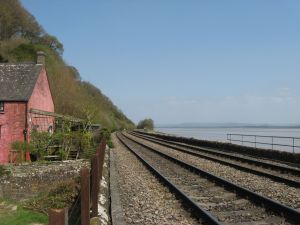
|
The background picture is
rather appropriate for this line, since it shows the railway
with rather hilly land on one side and a rather wide river on
the other. This was the attractive site of Gatcombe goods siding,
seen here looking towards Gloucester. Gatcombe used to be a port
of some renown but the arrival of the railway involved building
a viaduct across the mouth of the stream, rendering the port
inaccessible. Now trains swoosh past at speed, while a public
footpath allows access over the running lines to the riverbank
where locals moor their boats.
It is something of a shame
that this railway down the Severn Estuary simply isn't advertised,
but it does mean that new passengers are all the more surprised
as the train carries them past its scenic splendour - particularly
along this riverbank section between Lydney and Awre. |
For more information on
this line, try Gloucester
to Newport (Vic Mitchell and Keith Smith, Middleton Press),
which is about the only readily-available book to cover the whole
route. Other information has been gleaned from the many books
on the various branchlines along the way - the Wye Valley Railway,
the Severn and Wye Railway and the Forest of Dean Branch have
been quite well examined over the years. The Hereford, Ross and
Gloucester was covered in the June 2010 issue of Steam Days
magazine, which provided the interesting snippet on line ownership
around Grange Court. Cab Rides - Around the British Isles
- No. 16 (Cardiff to Birmingham) provides a driver's eye view
of the entire route on DVD, including the inside of Newnham Tunnel
(which is dark; what do you expect from a tunnel?). Devoid of
commentary, over twenty years old and from the cab of one of
the short-lived Class 155s, it makes an interesting historical
record which you can always try to watch in conjunction with
this webpage to see what's changed.
>>>Forest
of Dean Central Railway>>>
<<<Return
to Wye Valley Railway<<<
<<<Return
to Railways Department<<< |